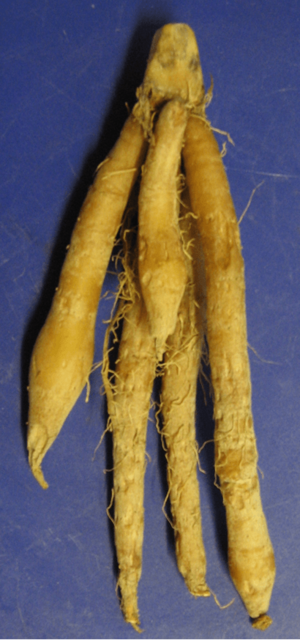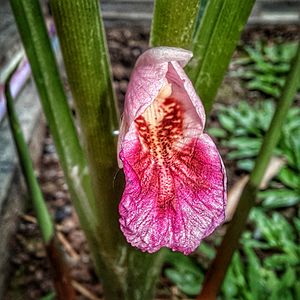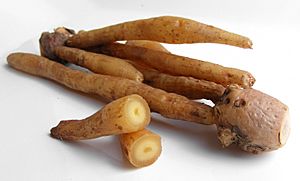Boesenbergia rotunda facts for kids
Quick facts for kids Boesenbergia rotunda |
|
|---|---|
 |
|
| Scientific classification | |
| Genus: |
Boesenbergia
|
| Species: |
rotunda
|
| Synonyms | |
|
|
Boesenbergia rotunda is a special plant often called fingerroot. You might also hear it called Chinese keys, lesser galangal, or Chinese ginger. It's a type of herb used in cooking and traditional medicine. This plant comes from China and Southeast Asia.
People call it fingerroot because its underground stem, called a rhizome, looks like fingers growing from a main part. It's related to ginger and turmeric.
Contents
What is Fingerroot?
Fingerroot is a plant that grows every year. It is native to southern Yunnan Province in China, all the way to western Malaysia. It loves to grow in warm, wet tropical rainforests.
How Fingerroot Grows
The most important part of the fingerroot plant is its rhizome. This is an underground stem that stores nutrients. It spreads out into many bunches, much like bananas, ginger, or turmeric do. The middle part of the rhizome is usually thicker than its ends. Inside, the rhizome can have different colors and smells, depending on the type of fingerroot.
Above the ground, the plant has a leaf stalk covered by a sheath. These leaf sheaths are red. The leaves themselves are oval-shaped with pointed tips. Fingerroot is a herbaceous plant, meaning it has soft stems, and it grows about 60 to 90 centimeters (2 to 3 feet) tall. Each leaf can be about 50 cm (20 inches) long and 12 cm (5 inches) wide. The middle of the leaf stalks has a deep groove.
Fingerroot Flowers
The flowers of the fingerroot plant grow between the leaf sheaths at the bottom of the main stem. Their petals are usually white or a light pink color. Only one flower blooms at a time.
Names Around the World
Fingerroot has many different names in various languages:
- Khmer: kcheay (ខ្ជាយ)
- Indonesian: temu kunci
- Meitei: yai-macha
- Sinhalese: haran kaha (හරං කහ)
- Thai: krachai (กระชาย)
- Vietnamese: ngải bún, nga truật
How People Use Fingerroot
Fingerroot is very popular in cooking, especially in Southeast Asia. It's also used for its special flavors, as a natural dye, and in traditional medicines.
In the Kitchen
- In Indonesia, fingerroot is called temu kunci. It's a key ingredient in many dishes, especially in Javanese cuisine.
- In Thai cuisine, it's known as krachai (Thai: กระชาย). You can find it in dishes like kaeng tai pla, which is a spicy curry.
- In Cambodian cuisine, it's called k'cheay (Khmer: ខ្ជាយ) and is used in special pastes called kroeung.
- Sometimes, you can find fingerroot pickled or frozen in Western countries.
- The rhizomes are often eaten as vegetables in main meals or raw when they are young.
- It's also used to help make tempeh, a traditional Indonesian food made from fermented soybeans.
- Fingerroot is grown in small gardens in Indonesia, Indochina, and India. It adds a lot of flavor to curry dishes.
Traditional Medicine
Fingerroot is also used in traditional health mixtures. For example, it's an ingredient in jamu, a famous traditional Indonesian tonic.
Sometimes, fingerroot is confused with another plant called Alpinia officinarum. This plant is also known as lesser galangal and belongs to the same plant family, Zingiberaceae.
See also
 In Spanish: Jengibre chino para niños
In Spanish: Jengibre chino para niños




